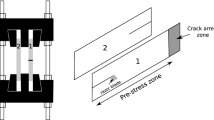Abstract
Polymethylmethacrylate (PMMA) is often used as a material in submarine applications. Therefore, the fracture properties of dry and wet PMMA in water and/or under hydrostatic pressure are of great importance. Previous work has shown that water strongly increases fracture toughness, and leads to a complicated figure of K 1 versus crack speed, and stable-unstable crack and craze propagation, depending on external loading rate. In this study, compact tension specimens immersed in water have been tested on a tensile machine and crack tips have been observed during propagation by means of optical interferometry. Fracture stress intensity factors, and craze-zone shapes and sizes have been measured as a function of loading time and crack speed in water. The results have been rationalized in terms of craze fibril stress versus fibril extraction velocity and craze fibril lifetime versus fibril stress. Both may be expressed in terms of a stress-activated process governing fracture. It is found that, when expressed in these terms, the complicated influence of the external loading rate becomes irrelevant for describing local intrinsic material properties and K 1 values. It is shown that there is no contradiction between the fact that water increases the fracture toughness, and the fact that the microscopic craze stress and craze fibril lifetime decrease at the crack tip.
Similar content being viewed by others
References
J. J. Benbow, Proc. Phys. Soc. B 78 (1961) 970.
Y. M. Mai, J. Mater. Sci. 10 (1975) 943.
V. A. Kefalas and A. S. Argon, ibid. 23 (1988) 253.
R. G. Hill, J. F. Bates, T. T. Lewis and N. Rees, ibid. 19 (1984) 1904.
J. G. Williams, Adv. Polym. Sci. 27 (1978) 67.
J. Shen, C. C. Chen and J. A. Saver, Polymer 26 (1985) 511.
J. J. Janacek and J. J. Kolarik, J. Polym. Sci. C 16 (1967) 279.
D. T. Turner, Polymer 23 (1982) 197.
Z. Miyagi and K. Tanaka, ibid. 16 (1975) 441.
J. M. Barton, ibid. 20 (1979) 1018.
P. J. Burchill and R. H. Stacewicz, J. Mater. Sci. Lett. 1 (1982) 446.
D. Putz and G. Menges, Br. Polym. J. 10 (1978) 69.
L. S. Smith and J. A. Sauer, Plast. Rubber Process. 6 (1986) 57.
P. Trassaert and R. Schirrer, J. Mater. Sci. 18 (1983) 3004.
R. Schirrer and G. Galleron, Polymer 29 (1988) 634.
Author information
Authors and Affiliations
Rights and permissions
About this article
Cite this article
Josserand, L., Schirrer, R. & Davies, P. Influence of water on crack propagation in poly methyl methacrylate: craze stress and craze fibril lifetime. JOURNAL OF MATERIALS SCIENCE 30, 1772–1780 (1995). https://doi.org/10.1007/BF00351609
Received:
Accepted:
Published:
Issue Date:
DOI: https://doi.org/10.1007/BF00351609




